Comments / Questions (22)
![]() Corina Avram wrote:
Corina Avram wrote:
Hi! Please help me understand this part "Row 1 (= WS): P all sts. Insert 1 marker 8-8-8-8-6-6 sts in from each side (= 8-8-8-8-6-6 sts on sleeve in each side, 32-34-36-36-40-46 sts on back piece between markers)". What exactly happends after casting on and Purling one time? Thanks a lot!
30.01.2024 - 13:40DROPS Design answered:
Dear Mrs Avram, after you have cast on all stitches, just purl all stitches, this will be the first row from wrong side, at the same time, insert markers to mark each part of the jumper. Happy knitting!
31.01.2024 - 08:12
![]() Stefania wrote:
Stefania wrote:
Buongiorno, non riesco a capire la spiegazione per eseguire il raglan. ci sono 6 maglie aumentate ma non riesco a capire come vanno aumentate e i segni dove vanno inseriti. grazie per la vostra risposta. Non è il primo modello che eseguo, ma con questo proprio non riesco a capire.
08.02.2023 - 16:04DROPS Design answered:
Buonasera Stefania, nelle spiegazioni del ferro 2 viene indicato il punto in cui eseguire gli aumenti; per lavorare gli aumenti deve seguire le indicazioni riportate nel paragrafo apposito. Buon lavoro!
11.02.2023 - 00:05
![]() Patricia wrote:
Patricia wrote:
Bonjour, j'ai relevé les mailles pour faire le col et je ne comprends pas comment relever la maille supplémentaire dans chaque première maille relevée. Est ce que je dois faire ressortir une maille de la maille relevée ? Merci pour votre réponse.
23.11.2022 - 12:05DROPS Design answered:
Bonjour Patricia, relevez ces 2 mailles derrière chacune des 2 premières mailles du tour, comme on le montre au time code 01:00 dans cette vidéo pour un col châle. Ainsi, les 2 premières mailles et les 2 dernières mailles du tour se chevauchent un tout petit peu. Bon tricot!
23.11.2022 - 15:59
![]() LUCQUIN Corinne wrote:
LUCQUIN Corinne wrote:
Où trouver le fil conseillé, à savoir drops you"4? Est-ce du coton ou de la laine, et par quoi le remplacer s'il vous plaît? merci...
14.03.2021 - 13:17DROPS Design answered:
Bonjour Corinne, vous pouvez utiliser la laine DROPSLovesYou 8, DROPS Nepal ou chaque laine du group C. Bon tricot!
14.03.2021 - 18:49
![]() Louise wrote:
Louise wrote:
Bonjour, je tricote ce modèle en taille M. Je ne comprends pas comment réaliser le col. Comment fait-on pour relever 90 à 110 mailles (et combien exactement ?) alors qu'il n'y a que 50 mailles de montées au départ ? J'ai regardé la vidéo mais il y a le même nombre de mailles. Également, si l'on tricote en aller-retour, il y aura une couture pour finir ou bien c'est l'ouverture à l'avant indiquée dans les explications qui fait office ? Merci d'avance.
22.05.2019 - 07:43DROPS Design answered:
Bonjour Louise, au début de ce pull, on tricote en allers et retours et on va augmenter pour le raglan mais également pour l'encolure devant = 4 m à la fin des rangs 2 à 5 puis 12 m à la fin des rangs 6 et 7. L'ouvrage se tricote en rond seulement après le 7ème rang. On aura donc suffisamment de mailles pour relever celles du col tout autour des mailles montées au début + celles montées de chaque côté pour l'encolure devant. Bon tricot!
22.05.2019 - 09:29
![]() Patricia Mendler wrote:
Patricia Mendler wrote:
Liebes Drops Team, Ich habe noch nie eine solche gebogene Nähnadel gesehen. Und finde sie aber genial. Könnt Ihr mir sagen, wo ich eine solche Nadel bekommen kann. Hat sie einen spezielle Bezeichnung. Vielen Dank schon einmal Herzliche Grüße Patricia
12.02.2019 - 19:08DROPS Design answered:
Liebe Frau Mendler, sicher kann Ihnen Ihr DROPS Laden weiterhelfen, nehmen Sie bitte Kontakt mit ihm - auch telefonisch oder per Email auf. Viel Spaß beim stricken!
13.02.2019 - 09:03
![]() Meike wrote:
Meike wrote:
Ich verstehe die 2. Reihe nicht. Auch weiß ich nicht was das * bedeutet. Wäre schön wenn sie mir das erklären könnten. Dankeschön
16.09.2018 - 04:26DROPS Design answered:
Liebe Meike, die 2. Reihe wird einfach so gestrickt, wie beschrieben. Die * werden bei den nächsten Hinreihen gestrickt - siehe z.B. Reihe 4: man muss dann von *bis* der 2. Reihe stricken. Viel Spaß beim stricken!
17.09.2018 - 09:02
![]() Caroline wrote:
Caroline wrote:
I would like to download/print this pattern 0-937 but the pdf is missing details on the righthand side of each page - it is not sizing correctly. Hope you can help ... Regards, Caroline
17.12.2016 - 18:32DROPS Design answered:
Dear Caroline, we tested printing successfully to this pattern, make sure to check your printer's settings, try to refresh and empty your browser's cache - your DROPS store will be also able to help you. Happy knitting!
19.12.2016 - 09:13
![]() Cecilia Fernandez Perez wrote:
Cecilia Fernandez Perez wrote:
Me pueden aclarar la parte en la que dice "despues aum 8 pts en la vuelta de la misna manera a cada 2 vtas (en mi caso) 17 veces mas y que despues a cada 4° vta 1 veces. Y que deveria tener 264 pts en la aguja. Me e perdido en esta parte. Muchas gracias
22.03.2015 - 19:44DROPS Design answered:
Hola Cecilia. Comenzamos con los aum cuando hay 112 pts para tu talla , ahora aum 144 pts (8 pts en la vta x un total de 18 vcs, cada 2ª vta) + 8 pts (8pts en la vta x 1 vez cada 4ª vta) = 112 + 144 + 8 = 264 pts.
26.03.2015 - 09:52
![]() Claudia wrote:
Claudia wrote:
Wo genau befindet sich der Rundenbeginn nachdem ich zur Runde geschlossen habe? Eigentlich müsste die Runde in der Mitte des Vorderteils anfangen, jedoch heißt es bei der Einteilung für den Rumpf, dass bei Rundenbeginn ALLE Maschen des Vorderteils gestrickt werden.
29.01.2015 - 21:17DROPS Design answered:
Liebe Claudia, wo genau Sie die Rd beginnen, ist bei diesem Modell nicht so wichtig, Hauptsache, Sie kommen bei den Raglanzunahmen nicht durcheinander und beenden jede Runde. Da noch eine Halsblende angestrickt wird und nur glatt re gestrickt wird, ist der Rd-Beginn am Vorderteil hinterher nicht mehr sichtbar. Wenn Ihnen das lieber ist, können Sie den Faden aber auch neu ansetzen, am besten am Beginn des Vorderteils.
30.01.2015 - 10:04
Autumn Love |
||||
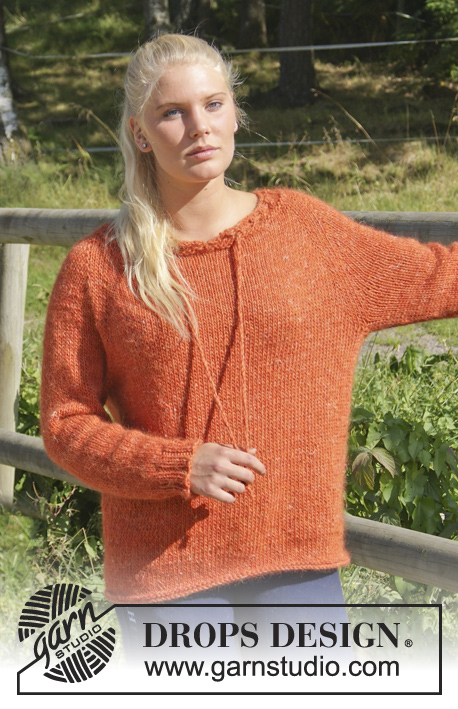 |
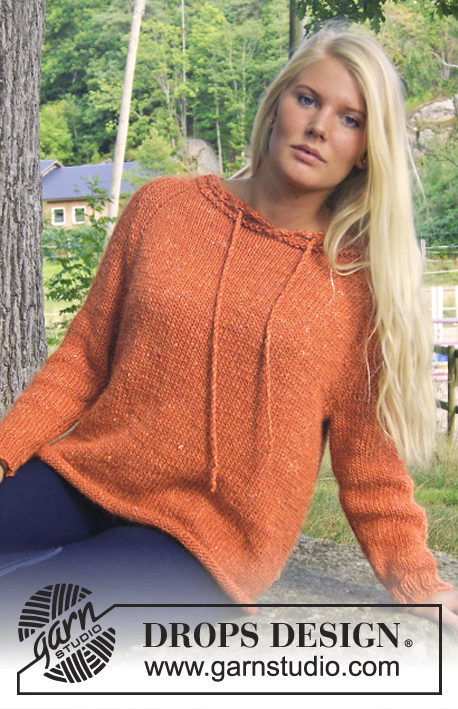 |
|||
Knitted DROPS jumper with raglan, eyelet holes and string, worked top down in ”DROPS ♥ YOU #4” or ”Nepal”. Size: S - XXXL.
DROPS Extra 0-937 |
||||
|
INCREASE TIP: Back and forth on needle: Inc 1 st from RS by making 1 YO, on next row P YO twisted. In the round on needle: Inc 1 st by making 1 YO, on next round K YO twisted. DECREASE TIP: Dec 1 st on each side of marker as follows: Work until 3 sts remain before marker, slip 1 st as if to K, K 1, psso, K 2 (marker is in the middle of these), K tog the next 2 sts. ---------------------------------------------------------- RAGLAN: The piece is worked from the neck down. First work back and forth until sts have been cast on for front piece, then work in the round. Cast on 48-50-52-52-52-58 sts on circular needle size 5.5 mm with orange. Row 1 (= WS): P all sts. Insert 1 marker 8-8-8-8-6-6 sts in from each side (= 8-8-8-8-6-6 sts on sleeve in each side, 32-34-36-36-40-46 sts on back piece between markers). Move the markers upwards when working. Row 2 (= RS): K 2, * inc 1 st - READ INCREASE TIP, K until 2 sts remain before next marker, inc 1 st, K 4 (marker is in the middle of these sts), inc 1 st, K until 2 sts remain before next marker, inc 1 st, K 4 (marker is in the middle of these sts), inc 1 st *, K until 2 sts remain on needle, inc 1 st, K 2 = 6 inc sts. Now cast on 4 sts on needle for front piece = 58-60-62-62-62-68 sts on needle. Row 3: P all sts, at the end of row cast on 4 sts = 62-64-66-66-66-72 sts. Insert 1 new marker 4 sts in from each side (= 4 sts on front piece in each side, 4 markers in total in piece). Row 4: K 6, (1st marker is after the first 4 sts), repeat from *-* from 2nd row, K until 2 sts remain before last marker, inc 1 st, K 6 (last marker is before the last 4 sts) = 6 inc sts. Cast on 4 sts = 72-74-76-76-76-82 sts on needle. Row 5: P all sts, at the end of row cast on 4 sts = 76-78-80-80-80-86 sts (= 8 sts on front piece in each side). Row 6: K 10, (1st marker is after the first 8 sts), repeat from *-* from 2nd row, K until 2 sts remain before last marker, inc 1 st, K 10 = 6 inc sts (last marker is before the last 8 sts). Cast on 11-12-13-13-15-18 sts = 93-96-99-99-101-110 sts on needle. Row 7: P all sts, at the end of row cast on 11-12-13-13-15-18 sts = 104-108-112-112-116-128 sts on needle (= 19-20-21-21-23-26 sts on front piece in each side, 38-40-42-42-46-52 sts on back piece and 14-14-14-14-12-12 sts on each sleeve). REMEMBER THE KNITTING TENSION! Then work piece in the round on needle as follows: ROUND 1: * K until 2 sts remain before next marker, inc 1 st, K 4 (marker is between these sts), inc 1 st *, repeat from *-* 3 more times (= 4 times in total), K the rest of round = 8 inc sts. ROUND 2: K all sts. Then inc 8 sts on round the same way - i.e. inc 1 st on each side of every marker - every other round 10-11-12-17-20-21 more times (11-12-13-18-21-22 inc in total on front piece), then every 4th round 3-3-3-1-0-0 times. When all inc are done, there are 216-228-240-264-284-304 sts on needle (= 66-70-74-80-88-96 sts on front and back piece, 42-44-46-52-54-56 sts on each sleeve). NOTE! Insert 1 marker in the mid on front piece (marks front piece which has shorter raglan). BODY: Worked in the round. Work next round as follows: Work 66-70-74-80-88-96 sts on front piece, * slip the next 42-44-46-52-54-56 sts (= sleeve) on 1 stitch holder, cast on 6-8-10-12-14-16 sts for armhole *, work the next 66-70-74-80-88-96 sts on back piece, repeat from *-* 1 more time = 144-156-168-184-204-224 sts on needle. Then work in stocking st over all sts. When piece measures 57-59-60-62-64-66 cm in total vertically (measured on the back), switch to circular needle size 5 mm. P 1 round, K 1 round, P 1 round and cast off with K on next round. SLEEVE: Worked in the round on double pointed needles size 5.5 mm. Cast on 3-4-5-6-7-8 sts on double pointed needles with orange, pick up 42-44-46-52-54-56 sts on stitch holder from one sleeve, cast on 3-4-5-6-7-8 sts on double pointed needles = 48-52-56-64-68-72 sts in total (= 6-8-10-12-14-16 sts for armhole). Insert 1 marker at beg of round (= mid under sleeve). NOTE: Now measure the piece from here. Continue to work in stocking st in the round for 3 cm. On next round dec 1 st - READ DECREASE TIP - on each side of marker. Repeat dec every 5½-5-4-2½-2½-2 cm 6-7-8-12-13-14 more times (7-8-9-13-14-15 times in total) = 34-36-38-38-40-42 sts. Continue in stocking st until piece measures 41-40-40-39-39-38 cm. On next round switch to double pointed needles size 5 mm, K while AT THE SAME TIME inc 10-8-10-10-12-10 sts evenly on round = 44-44-48-48-52-52 sts. Continue to work rib as follows: * K 2, P 2 *, repeat from *-* the entire round. When rib measures 5 cm, loosely cast off all sts with K over K and P over P, sleeve measures approx. 46-45-45-44-44-43 cm (shorter measurements in the larger sizes because of wider shoulders). ASSEMBLY: Sew tog opening under sleeves. NECK EDGE: Worked back and forth on circular needle from mid front. Beg mid front and pick up from RS approx. 90 to 110 sts on circular needle size 5.5 mm around the neck. Pick in addition up 1 more st in each of the first 2 sts picked up. This way the neck edge will overlap somewhat and give a nice opening mid front. Turn piece and K row from WS. Turn piece, K tog the first 2 sts from RS, K the rest of row. Turn piece, P tog the first 2 sts, P the rest of row. Turn piece and K tog the first 2 sts, K 1, * K 2 tog, 1 YO *, repeat from *-* the entire round and finish with K 3. Turn and work all sts and K YOs from WS. Cast off with K from RS. Neck edge measures approx. 3 cm. TWINED STRING: Cut 2 lengths of 3 metres each. Twine the strands tog until they resist, fold the string double so that it twines again. Make a knot at each end. Thread the string through row with eyelet holes. |
||||
Diagram explanations |
||||
|
||||
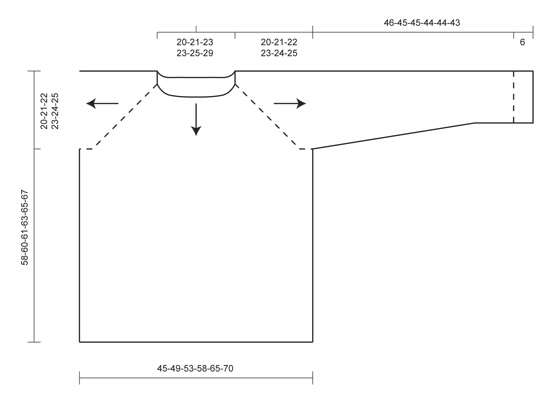
|
||||
Have you finished this pattern?Tag your pictures with #dropspattern or submit them to the #dropsfan gallery. Do you need help with this pattern?You'll find 16 tutorial videos, a Comments/Questions area and more by visiting the pattern on garnstudio.com. © 1982-2025 DROPS Design A/S. We reserve all rights. This document, including all its sub-sections, has copyrights. Read more about what you can do with our patterns at the bottom of each pattern on our site. |
||||







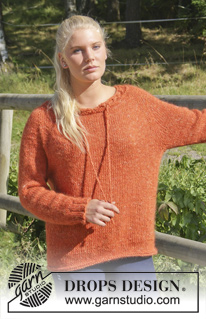
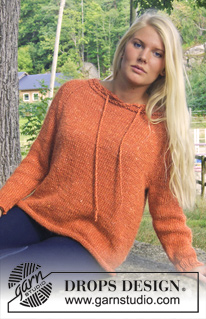









































Post a comment to pattern DROPS Extra 0-937
We would love to hear what you have to say about this pattern!
If you want to leave a question, please make sure you select the correct category in the form below, to speed up the answering process. Required fields are marked *.